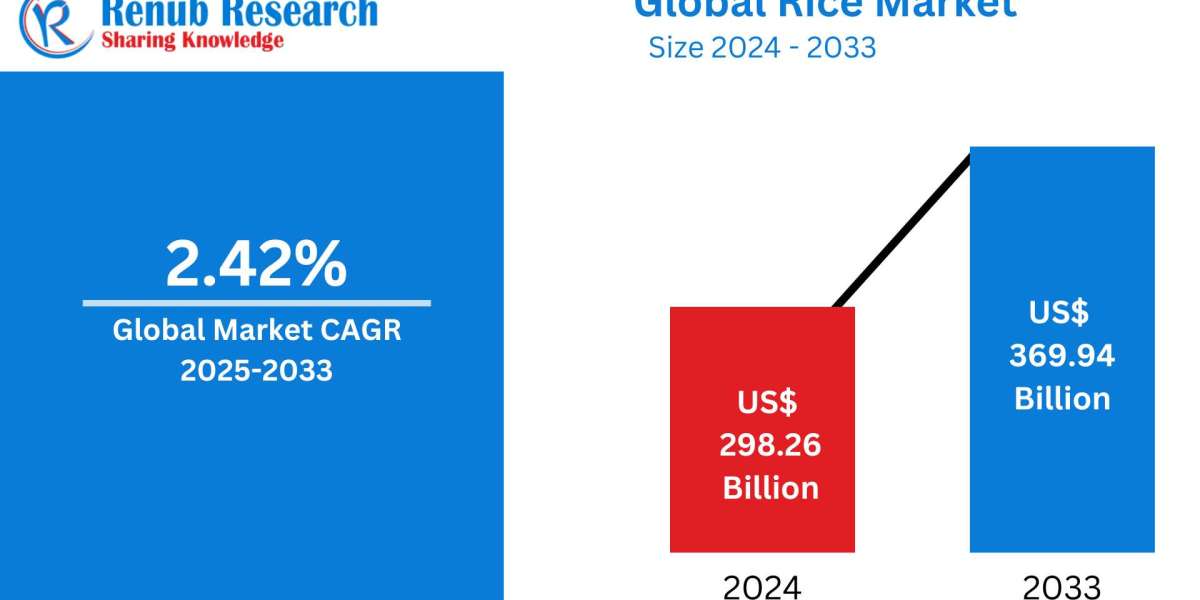? Global Rice Market Size, Share & Forecast Analysis (2025 – 2033)
Market Overview
The Global Rice Market is projected to reach US$ 378.41 Billion by 2033, up from US$ 305.14 Billion in 2024, registering a CAGR of 2.42% during the forecast period 2025 to 2033. This steady growth is driven by rising global population, evolving dietary preferences, international trade agreements, government support policies, and the increasing demand for rice-based convenience foods.
? Global Rice Industry Landscape
Rice, a staple for over half the world’s population, holds strategic importance in global food security. Cultivated across more than 120 countries, with Asia accounting for 90% of both global production and consumption, rice ranks third in global agricultural production after maize and sugarcane. China and India collectively produce nearly 50% of the global rice output.
As per FAOSTAT, in 2022, the global rice cultivation area exceeded 165 million hectares, with India alone harvesting over 48 million hectares, making it the largest rice-producing country.
? Key Market Growth Drivers
- Government Policies & Agricultural Support
Governments worldwide are actively supporting rice production through price supports, subsidies, and R&D investments. These interventions stabilize market prices and encourage innovation in high-yield and climate-resilient rice varieties.
Example:
In February 2024, the Indian government launched "Bharat Rice" at Rs 29/kg (USD 0.35) to combat retail inflation in food grains.
- Surge in Convenience Food Consumption
Urbanization and busier lifestyles are fueling the popularity of instant rice products, including frozen rice bowls, microwave pouches, and instant noodles.
Additionally, rice-based snacks (like rice cakes and chips) are gaining traction among health-conscious consumers due to their gluten-free and low-fat attributes.
- Expanding Export Opportunities
Globalization and favorable trade agreements have unlocked new markets for rice-exporting countries. Exporters can now cater to diverse tastes with variants like long-grain, aromatic, parboiled, sushi, and brown rice. Stringent quality certifications boost international confidence in imported rice, further encouraging trade.
⚠️ Challenges Restraining Market Growth
- Supply-Demand Imbalances
Production disruptions due to weather, pests, or disease can cause shortages and price spikes, while overproduction can depress prices and farmer incomes. These fluctuations are particularly destabilizing for developing nations.
- Price Volatility
Government policies (e.g., export bans), global economic shifts, inflation, and speculative trading contribute to price volatility. This uncertainty affects stakeholder planning, investment, and consumer affordability.
? Regional Market Insights
?? United States
The U.S. rice market is expanding due to its incorporation in diverse cuisines and shifting dietary patterns. In 2023, the U.S. rice output surged by 36% YoY to 9.89 million metric tons, with a 32% increase in harvested area, driven by favorable conditions and advanced techniques.
The growing demand for brown and wild rice and the booming food service and processing sectors further support growth.
?? India
India's rice market is propelled by rapid population growth and increasing export demand. With over 152.2 crore people projected by 2036, rice remains the primary dietary staple.
Processed rice products and innovations like DAAWAT® Jasmine Thai Rice (launched in December 2024) reflect growing consumer interest in global cuisines.
Sustainability efforts are gaining momentum with Diageo India's regenerative agriculture project, which supports 220 farmers and 500 hectares in Telangana.
?? Germany
Heavily reliant on imports, Germany's rice market leans toward high-quality, processed rice products, especially long-grain rice. Consumption is influenced by ethnic diversity and health-conscious trends. EU trade policies and environmental factors shape market dynamics.
?? United Arab Emirates
The UAE imports the majority of its rice, particularly premium and Basmati varieties, from India, Pakistan, and Thailand. A growing expatriate population and preference for convenient, high-quality foods ensure sustained demand.
However, climate limitations and water scarcity constrain domestic production.
? Rice Market Segmentation
By Product Type
- Regular
- Aromatic
By Type
- Red Rice
- Arborio Rice
- Black Rice
- Grain Fragrance Rice
- Brown Rice
- Rosematta Rice
- Grain Parboiled Rice
- Sushi Rice
- Others
By Grain Size
- Long Grain
- Medium Grain
- Short Grain
By Distribution Channel
- Offline
- Online
By Application
- Food
- Feed
- Others
? Country Analysis (25 Key Markets)
North America:
United States, Canada
Europe:
France, Germany, Italy, Spain, United Kingdom, Belgium, Netherlands, Turkey
Asia Pacific:
China, Japan, India, Australia, South Korea, Thailand, Malaysia, Indonesia, New Zealand
Latin America:
Brazil, Mexico, Argentina
Middle East & Africa:
South Africa, Saudi Arabia, United Arab Emirates
? Key Companies Profiled
- KRBL Limited
- LT Food Ltd
- Kohinoor Foods
- Thai Wah
- Archer Daniels Midland
- Tate & Lyle
- General Mills
- MGP Ingredients
Company Insights Include:
- Overview
- Key Personnel
- Recent Developments
- Sales Analysis
? Report Highlights
Feature | Details |
Base Year | 2024 |
Forecast Period | 2025 – 2033 |
Market Size | US$ Billion |
Segments Covered | Product Type, Type, Grain Size, Distribution Channel, Application, Countries |
Customization Scope | 20% Free |
Analyst Support | 1 Year |
Delivery Format | PDF, Excel (Word/PPT on request) |
? Pricing Options
- Dashboard (Excel): $2,490
- Single User License (PDF): $2,990
- Five User License + Excel: $3,490
- Corporate License: $3,990
? Contact Us
? USA: +1-678-302-0700
? India: +91-120-421-9822
✉️ Email: info@renub.com
Related Reports
- Corn Starch Market Forecast 2025–2033
- Food Enzymes Market Trends
- Global Corn Market Report
- Wheat Starch Market Analysis



